David Melling


About Author
David grew up in London with various siblings and a selection of animals. It took him a while to decide what he wanted to do with his pencils (he never stopped drawing), until he began illustrating children's books. In 2001 he wrote and illustrated the first of his own picture books, The Kiss That Missed, and today he is probably best known for his Hugless Douglas series. To date he has created around 170 books in over 30 languages. David lives in Oxfordshire with his wife and two teenage children.
Website: David Melling Twitter: David Melling1
Interview
Goldilocks and the Three Crocodiles (HarperCollins Children's Books)
June 2023
If you love your fairy tales with a twist, then look no further than Michael Rosen and David Melling's picture book, Goldilocks and the Three Crocodiles. Michael Rosen takes us back into the world of mischievous Goldilocks and brings her a new adventure. This time around, though, the three owners of the house, the chairs, the porridge and the beds are slightly toothier....
David Melling, whose illustrations bring the story to life, spoke to ReadingZone about fairy tale retellings, scary crocodiles, and reminiscing on Michael Rosen's We're Going on a Bear Hunt in this new picture book story, which is now available in paperback.
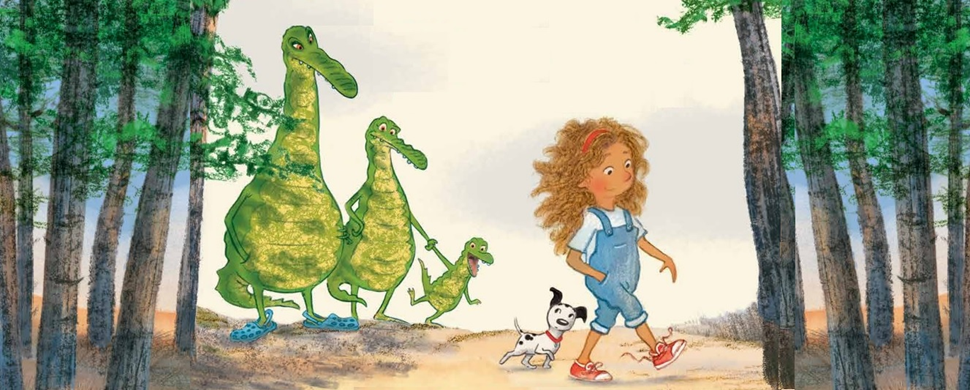
Illustrations by David Melling from Goldilocks and the Three Crocodiles
Q&A with illustrator David Melling
1. Can you tell us a little about yourself and the kinds of books you enjoy creating?
Thanks so much for inviting me to do this Q&A. I've been working with children's books for 30 years now. I always think of myself as an illustrator first. It was only later that I tried writing. The first picture book I wrote and illustrated was The Kiss That Missed (2001). I really enjoy drawing character-based animals and try to pack as much humour into them as possible.
2. You generally write and illustrate your own books - so what drew you to illustrating Michael Rosen's Goldilocks and the Three Crocodiles?
I've always enjoyed fairy tales, especially with a modern twist, so when I was shown the Goldilocks text from HarperCollins I was very excited. I'm such a fan of Michael's writing and realised it was a wonderful opportunity.
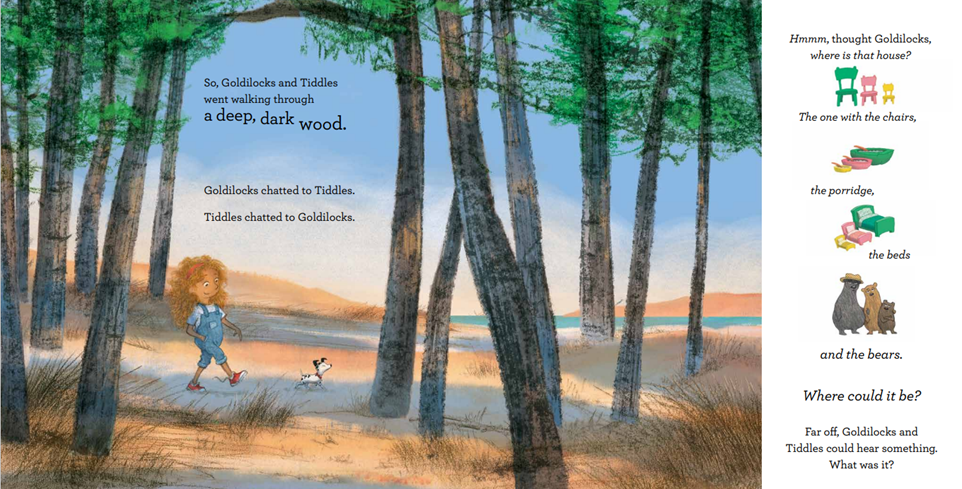
3. How did you go about deciding what these ones would look like? How challenging is it to draw crocodiles, and to make them look fierce but not too fierce?
That's an interesting question! I draw animals all the time, so the prospect of drawing crocodiles was very appealing. For me, posture and expression play very important roles in how I go about designing characters. I'm looking for clues in the text; the way a character speaks, what they wear and how they behave. All that is in my mind when I'm drawing.
I might also look for reference photographs of real crocodiles, which give me clues and remind me more specifically of their appearance; shapes, texture etc. I might then exaggerate some of these elements and add them into the mix. It's a process that can sometimes happen very quickly and other times take forever!
4. How did you decide what Tiddles (the girl's dog) would look like?
It was Michael's idea to have Tiddles as a dog. I liked the idea of him being small and quick. I also think of how a character might move when I start drawing, which can really help me 'find' the character I'm looking for.
5. What were the other challenges in illustrating this text? (fish chairs, shell beds?)
Yes, I must admit, I swallowed hard when I read fish chairs! But I loved the challenge. I mean, how do you come up with fish chairs? Brilliant! Shell beds were also tricky, mainly due to the scale. The crocodiles were clearly very big, with the text describing 'three huge shells,' yet she 'squeezes' into them. In the end, we settled for a little artistic licence.
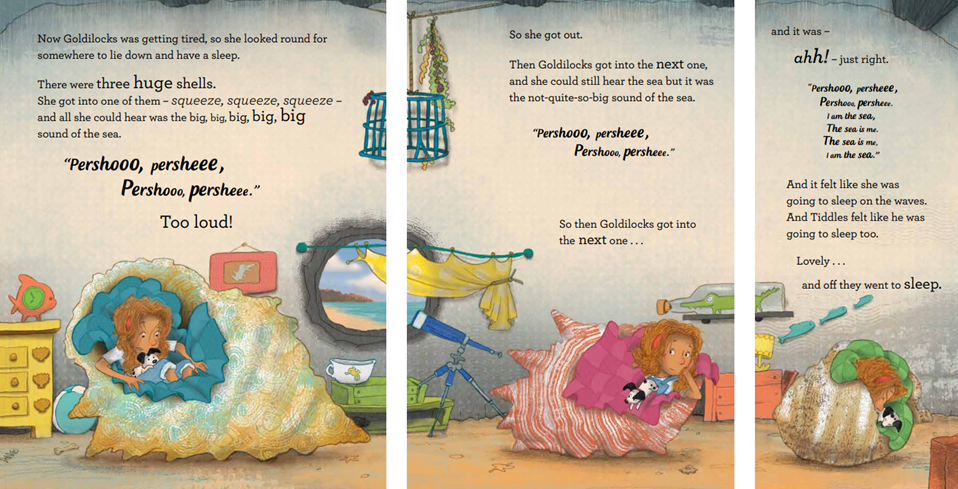
6. There are echoes of Michael Rosen's We're Going on a Bear Hunt in this picture book - did you check that out before you started on this, and did you also want the illustrations, like the seascape and cave, to reflect the connection?
Yes, I was aware of a bear-hunt crossover here and I did mention it to my editor. If it was written by anyone else but Michael I would have had major concerns but I figured well, he wrote both stories…if he's happy, I'm happy!
I worked closely with my editor to establish the kind of wind-swept feel to the illustrations and the kind of cave and décor the crocodiles would create. Throughout that process, and while I was submitting drawings, we didn't mention bear-hunt once. I just put it out of my mind.
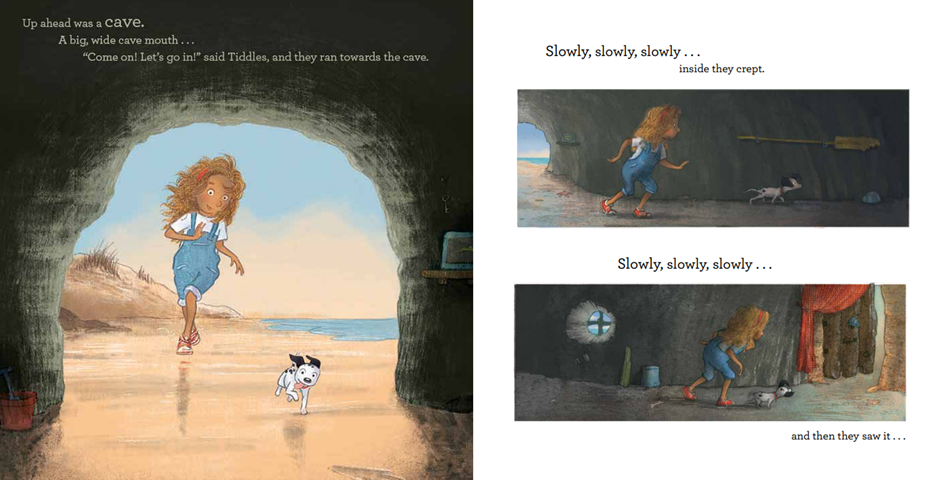
7. You've also included lots of funny details in the illustrations- any favourites? Why do you feel it's important to have these details for young children to spot?
My favourite detail is probably Dad croc wearing his croc shoes. Looking back, I wish I had them all wearing colour co-ordinated crocs, that would have been fun!
I've always tried, wherever possible, to add little details in my illustrations. As I child, I remember my favourite books; the Asterix & Obelix series. I would read the story (the words), then go back and read the pictures. Because, of course, that's exactly what young children are doing; listening to the story while reading the pictures. As an illustrator, for me, I think this is very important. I've always tried to add 'little extras' that readers may not see the first time round but notice during subsequent readings
8. How do you create your illustrations? How long did it take to complete this book?
After spending most of my career working with traditional pen and watercolour materials on paper, I recently made the decision to try working digitally. I thought it would be interesting to try and bring something new and fresh to my work.
Working digitally has allowed me to bring new techniques to my final pictures. I always start the same way, though; I draw everything first with pencil on paper and then scan everything into Photoshop. Then, I colour digitally with the amazing range of brushes Photoshop have to offer.
I might also draw and paint shapes and textures on paper then scan and drop those into Photoshop too. I'll then go about montaging the various elements…a bit like a creating digital collage.
Goldilocks took me much longer than most books I've done - around 6 months. But, to be fair, working digitally, and learning how to operate Photoshop, played a big part in this.
9. Do you have a favourite spread, and if so why that one?
Probably the crocodile spreads, towards the end. If there was one issue I had, illustrating this book, there simply weren't enough crocodiles to illustrate!
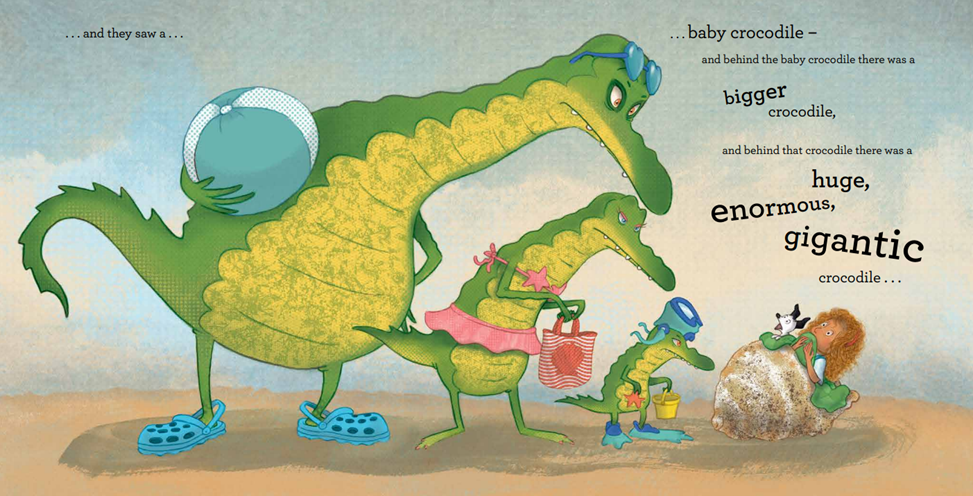
10. Will you be doing any other picture books with Michael? What are you working on currently?
I can answer both questions with one answer; yes, I'm currently working on my second book with Michael called Not so, Little Red Riding Hood. If all goes well, it will be published in the autumn.
And finally....If you could have a fairytale-inspired studio, what would it look like?
In a small cottage surrounded by beautiful, bright forest (you can keep the "deep and dark" bit), and surrounded by animals. Friendly animals, mind you, that don't mind if I borrow their fish chairs or shell beds....
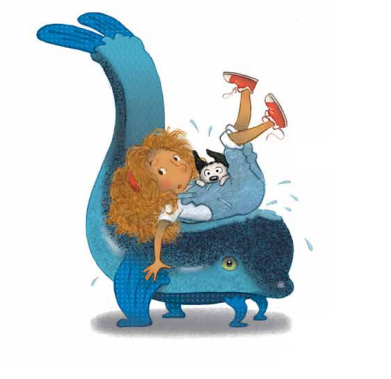
Thank you for joining us on ReadingZone, David!
 Goldilocks and the Three Crocodiles (paperback)
Goldilocks and the Three Crocodiles (paperback)
 Ruffles and the Cosy, Cosy Bed
Ruffles and the Cosy, Cosy Bed
 Ruffles and the Teeny Tiny Kittens
Ruffles and the Teeny Tiny Kittens
 Ruffles and the Red, Red Coat
Ruffles and the Red, Red Coat
 Hugless Douglas and the Nature Walk
Hugless Douglas and the Nature Walk
 Hugless Douglas Goes to Little School
Hugless Douglas Goes to Little School
 We Love You, Hugless Douglas!
We Love You, Hugless Douglas!
 The Kiss That Missed
The Kiss That Missed
